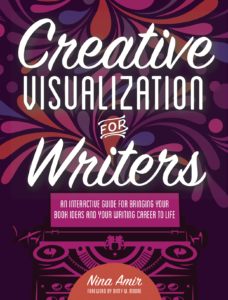Guest post: A different approach to book promotion
Today’s guest post by Nina Amir is part of her book tour for the recently released Creative Visualization for Writers. Nina is also the Amazon-bestselling author of such books as How to Blog a Book and The Author Training Manual. As an author coach, Nina supports writers on the journey to successful authorship. Some of her clients have sold 300,000+ copies of their books, landed deals with major publishing houses, and created thriving businesses around their books. Learn more about Nina on her website.
A different approach to book promotion
By Nina Amir
Most writers hate promoting their work. They resist those pre-publication book promotion activities referred to as author platform-building. And they avoid post-publication book promotion or marketing.
If you can relate, I’ve got news for you. That attitude won’t help your book sell. And if it doesn’t sell, it won’t end up in the hands of readers. That means it won’t get read — and I know that’s not what you want.
You could muscle through — force yourself to build platform and promote. But there are other approaches that don’t require muscle and still increase your promotion comfort level and enhance your book marketing ability.
My book, Creative Visualization for Writers: An Interactive Guide for Bringing Your Book Idea and Writing Career to Life, offers a variety of exercises to help writers change their mindset about promotion. Try the following four exercises, which are revised excerpts from my book, to put that process in motion.
1. Evaluate your willingness to succeed with book promotion.
To develop a career as a successful author — or to develop even just one successful book — you must do more than write. In addition to your writer’s hat, you have to wear a promoter’s hat.
But are you willing to wear both hats? Or will you only wear a writer’s hat?
To find out, answer these two crucial questions:
-
Are you willing to be more than a writer? Why or why not?
-
Are you willing to do what it takes — whatever it takes — to achieve your goals? Why or why not?
Becoming a successful writer takes a ton of willingness.
-
On a scale of 1 to 10, with 10 being the most willing, how willing are you to do what it takes to make your dreams real? Why?
-
What are you willing or unwilling to do to achieve your creative writing goals? Why?
-
What are you willing to do to achieve your creative goals?
2. Call on your inner sales rep.
Research shows that your inner voice either helps or hinders your ability to achieve goals. The affirmation “I can do it” keeps you moving forward if you are a courageous person, but if your inner voice is fearful, you’ll balk at taking that first step.
Your “self” is comprised of many “selves.” By this, I don’t mean that you have multiple personalities but numerous energetic parts that live within you and influence your life. They affect your decisions, emotions, thoughts, behaviors, relationships, and whether you achieve your goals and create your dreams.
Your “inner sales rep” loves promotion and marketing. This self’s preferred activity is selling, and it sees no conflict between art and commerce.
Call upon this self when you need to pre-promote your book by building your author platform. This “you” is happy to help attract a fan base or do whatever it takes to build your mailing list or social network following. This is the self you want in full force when you release your book, as it will gladly assist you with marketing.
If you want good ideas about how to promote yourself and your work, talk to your inner sales rep. And when you feel uncomfortable pitching your work or encouraging potential readers to buy your book, invoke the energy of this self.
Ask your inner sales rep the following questions.
-
What promotion or marketing techniques would I enjoy most? Why?
-
What promotion or marketing techniques would work best for me and my books? Why?
-
What is the one thing I can do right now that will help me build a platform quickly? Why?
-
What is the one thing I can do right now that will help me sell the most books?
 3. See yourself overcoming obstacles.
3. See yourself overcoming obstacles.
The fact that you don’t like promotion creates an obstacle to successful authorship — unless you decide to pay someone to take over your book marketing. Even then, you are at a disadvantage. After all, the author is the best person to promote a book.
But you can overcome this obstacle with visualization.
Athletes visualize themselves achieving success as well as overcoming physical exhaustion, self-doubt, pain, and competition.
In the same manner, make a list of the obstacles you might encounter on your way to bringing your idea or dream to life — including resistance to marketing your book, promotions that don’t work, or failing to get on the Amazon bestseller list upon book launch.
Now visualize yourself overcoming each obstacle.
4. Set book sales goals.
It’s enormously important to have specific goals related to book sales. If you want to sell enough copies to become a New York Times or Amazon bestselling author, you need to know what that takes and create goals that can make that dream real.
Maybe becoming a best-selling author doesn’t interest you. You want your book to make a difference in a few people’s lives, leave a legacy for your kids, or boost your business. In these cases, the number of copies you want to sell — or give away — differs from that of someone who wants to become a best-selling author.
The average book today only sells 250 copies per year and three thousand in its lifetime. The average e-book author sells 560 books per year. You, of course, do not have to be average!
To ensure this result, set book sales goals to rise above the competition.
-
I WILL SELL ______COPIES OF BOOKS PER YEAR.
-
I WANT TO SELL ______ COPIES OF MY BOOK EACH QUARTER.
-
IT IS IMPORTANT TO ME TO SELL THIS QUANTITY OF BOOKS BECAUSE_____________________.
Now make a list of all the ways in which you are willing to help get your books in the hands of readers. In other words, create your promotion plan
When you develop the willingness to help your book succeed, know how to visualize success, call on the parts of yourself that can help you promote, and have clear goals about your book sales (and why you want to sell those books), you’ll find yourself more inclined to promote your book before and after launch. That means your books will get read, which is every writer’s ultimate goal.
When you visualize success as an author, what does that mean to you? What do you see?
Tip of the Month
 I always share a “Tip of the Month,” a free resource or tool for authors, on the last Wednesday of the month.
I always share a “Tip of the Month,” a free resource or tool for authors, on the last Wednesday of the month.
This week’s tip is for those of you who know you should be writing book-related op-eds — opinion essays — for newspapers and other media outlets. Op-eds are a subtle, but effective, book publicity tool. They allow you to use your expertise or the knowledge you gained researching your book to express an opinion about an important topic in the news. (Learn more in “Using op-eds for book promotion” and “How to write an op-ed column or essay.”)
Authors using this tactic often ask me, “Is there a directory that lists newspapers that run op-eds?”
Yup!
If op-eds are part of your book marketing plan, bookmark the “Opinion Yellow Pages.” This site lists op-ed editors and their contact information for influential print and online media outlets. It will save you hours of research.
Like what you’re reading? Get it delivered to your inbox every week by subscribing to the free Build Book Buzz newsletter. You’ll also get my free “Top 5 Free Book Promotion Resources” cheat sheet immediately!



One Comment